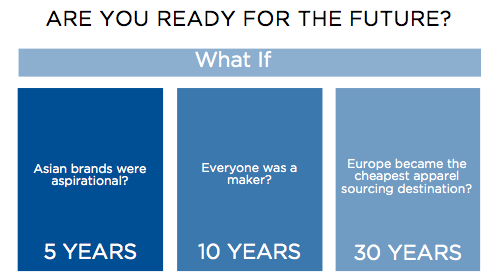
The fashion industry has gone through dramatic changes in the last 20 years and finds itself at a crossroads. Resource scarcity is triggering shifts in business models and supply-chains; waste is the new resource; customers are the sales channel of the future; and legislation is becoming ever more stringent.
2045: scenarios for the textile and fashion industry: How will the industry look like in 5, 10 and 30 years time? Scenarios offer research-based insights, and potentially can show how realistic a world is, that looks rather quite different from what we’re used to.
What if Asia became today’s Europe?
The present: Asian brands are becoming aspirational for Western consumers and hence compete directly with Western brands. But: Asian, just as Western, brands target primarily Asian consumers. As cost of labour increases in Asia, particularly China, factories relocate to cheaper, more rural areas.
The future: Asian manufacturers are traders to African manufacturers and producers, but ethical standards remain low. Workers from Western markets migrate East and are the new “cheap labour”. While Asia has become the main market for European brands, Asian and African culture is shaping the global mainstream.
What if everyone was a maker?
The present: “Made in [your country]” is experiencing a revival across all Western markets. Virtual reality – from sampling to dressing rooms – is entering the retail landscape. Raw material prices keep rising. And at a time when 3D printing has finally matured sufficiently to become mainstream, physical and virtual maker markets such as Etsy gain popularity.
The future: The situation is paradox: on the one hand localism reigns, but on the other the world has never been any more global. “Made in [your area]” products are sought after, but rather than being a luxury they are the typical way of life. Fragmentation is the key word both for manufacturing and retail: independent boutiques are proliferating, and communities are geographically semi-isolated yet technologically hyper-connected.
What if we didn’t buy to own?
The present: Swishing is a new lifestyle, and Ebay and Amazon are where people flog their unused goods. Repair services are part of the offering of certain fashion brands. Car sharing, tool sharing, skill sharing are being rolled out on a large scale. The sharing economy is valued at $460 billion and is expected to grow 15% in the next 15 years.
The future: Cotton, polyester and most other fibres are difficult to get by. New generation fibres can’t cope with the demand. World population has grown to an extent that agricultural activities are geared towards food. Few products are discarded, and broken and ripped ones are valued as raw material source. Buy-to-own is not the predominant lifestyle any more, but is considered a luxury. Communities offer rental services for more expensive and rare items, including clothing.
2045: Competitiveness in the fashion industry
The preparation for future industry scenarios has proven to be among the most effective tools for a sustained business development across all operations. The changes that affect the fashion industry are triggering radical market shifts. Only businesses that can and are willing to anticipate them will survive, remain competitive and thrive in the long run.
Scenario work also encourage and facilitate the collaboration of executives from different departments and develop a common vision for the future of their company. Participants have the chance to develop a common vocabulary around key issues that will affect their business and will become dominant in the mid to long run.

